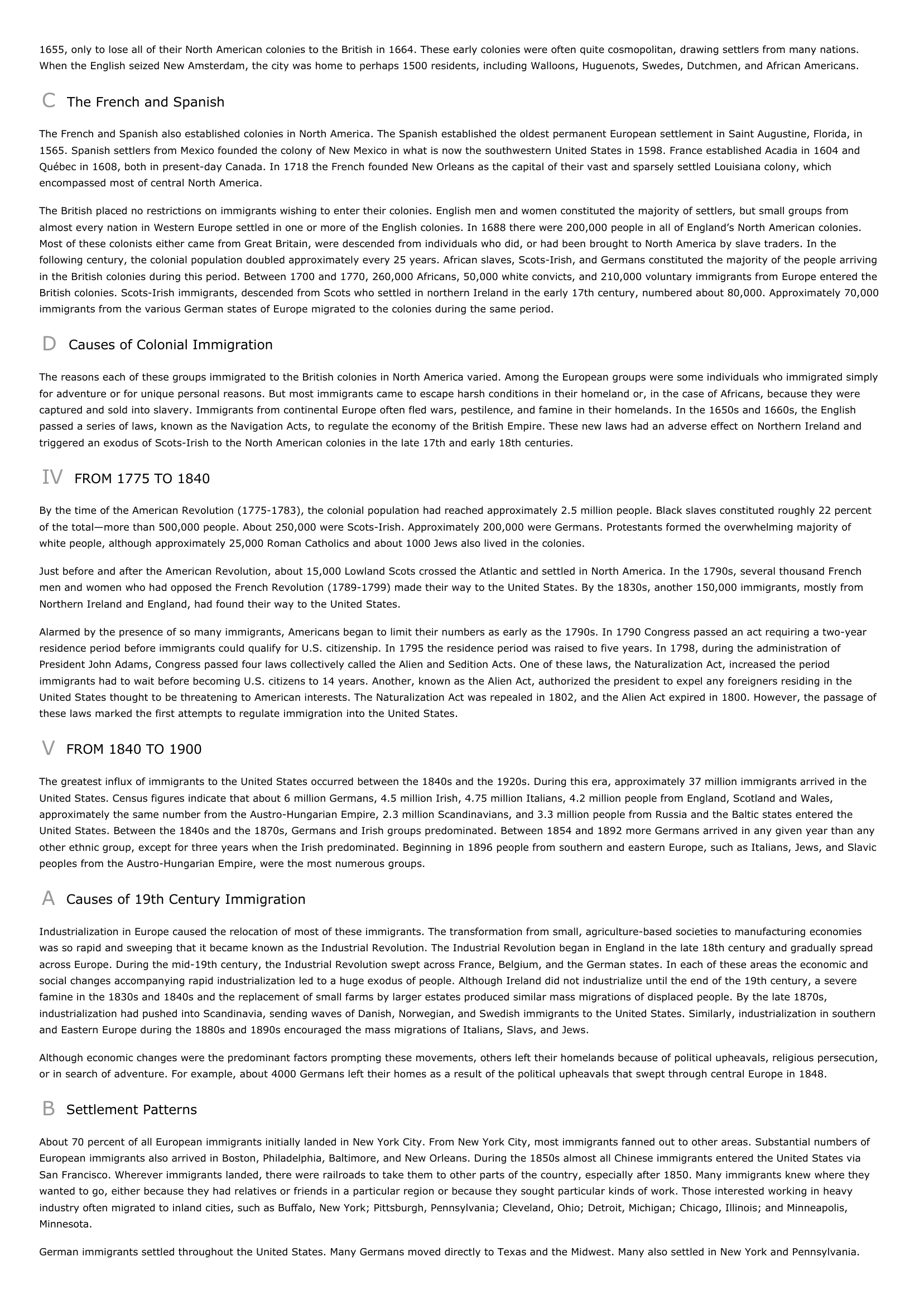Immigration.
Publié le 10/05/2013

Extrait du document


«
1655, only to lose all of their North American colonies to the British in 1664.
These early colonies were often quite cosmopolitan, drawing settlers from many nations.When the English seized New Amsterdam, the city was home to perhaps 1500 residents, including Walloons, Huguenots, Swedes, Dutchmen, and African Americans.
C The French and Spanish
The French and Spanish also established colonies in North America.
The Spanish established the oldest permanent European settlement in Saint Augustine, Florida, in1565.
Spanish settlers from Mexico founded the colony of New Mexico in what is now the southwestern United States in 1598.
France established Acadia in 1604 andQuébec in 1608, both in present-day Canada.
In 1718 the French founded New Orleans as the capital of their vast and sparsely settled Louisiana colony, whichencompassed most of central North America.
The British placed no restrictions on immigrants wishing to enter their colonies.
English men and women constituted the majority of settlers, but small groups fromalmost every nation in Western Europe settled in one or more of the English colonies.
In 1688 there were 200,000 people in all of England’s North American colonies.Most of these colonists either came from Great Britain, were descended from individuals who did, or had been brought to North America by slave traders.
In thefollowing century, the colonial population doubled approximately every 25 years.
African slaves, Scots-Irish, and Germans constituted the majority of the people arrivingin the British colonies during this period.
Between 1700 and 1770, 260,000 Africans, 50,000 white convicts, and 210,000 voluntary immigrants from Europe entered theBritish colonies.
Scots-Irish immigrants, descended from Scots who settled in northern Ireland in the early 17th century, numbered about 80,000.
Approximately 70,000immigrants from the various German states of Europe migrated to the colonies during the same period.
D Causes of Colonial Immigration
The reasons each of these groups immigrated to the British colonies in North America varied.
Among the European groups were some individuals who immigrated simplyfor adventure or for unique personal reasons.
But most immigrants came to escape harsh conditions in their homeland or, in the case of Africans, because they werecaptured and sold into slavery.
Immigrants from continental Europe often fled wars, pestilence, and famine in their homelands.
In the 1650s and 1660s, the Englishpassed a series of laws, known as the Navigation Acts, to regulate the economy of the British Empire.
These new laws had an adverse effect on Northern Ireland andtriggered an exodus of Scots-Irish to the North American colonies in the late 17th and early 18th centuries.
IV FROM 1775 TO 1840
By the time of the American Revolution (1775-1783), the colonial population had reached approximately 2.5 million people.
Black slaves constituted roughly 22 percentof the total—more than 500,000 people.
About 250,000 were Scots-Irish.
Approximately 200,000 were Germans.
Protestants formed the overwhelming majority ofwhite people, although approximately 25,000 Roman Catholics and about 1000 Jews also lived in the colonies.
Just before and after the American Revolution, about 15,000 Lowland Scots crossed the Atlantic and settled in North America.
In the 1790s, several thousand Frenchmen and women who had opposed the French Revolution (1789-1799) made their way to the United States.
By the 1830s, another 150,000 immigrants, mostly fromNorthern Ireland and England, had found their way to the United States.
Alarmed by the presence of so many immigrants, Americans began to limit their numbers as early as the 1790s.
In 1790 Congress passed an act requiring a two-yearresidence period before immigrants could qualify for U.S.
citizenship.
In 1795 the residence period was raised to five years.
In 1798, during the administration ofPresident John Adams, Congress passed four laws collectively called the Alien and Sedition Acts.
One of these laws, the Naturalization Act, increased the periodimmigrants had to wait before becoming U.S.
citizens to 14 years.
Another, known as the Alien Act, authorized the president to expel any foreigners residing in theUnited States thought to be threatening to American interests.
The Naturalization Act was repealed in 1802, and the Alien Act expired in 1800.
However, the passage ofthese laws marked the first attempts to regulate immigration into the United States.
V FROM 1840 TO 1900
The greatest influx of immigrants to the United States occurred between the 1840s and the 1920s.
During this era, approximately 37 million immigrants arrived in theUnited States.
Census figures indicate that about 6 million Germans, 4.5 million Irish, 4.75 million Italians, 4.2 million people from England, Scotland and Wales,approximately the same number from the Austro-Hungarian Empire, 2.3 million Scandinavians, and 3.3 million people from Russia and the Baltic states entered theUnited States.
Between the 1840s and the 1870s, Germans and Irish groups predominated.
Between 1854 and 1892 more Germans arrived in any given year than anyother ethnic group, except for three years when the Irish predominated.
Beginning in 1896 people from southern and eastern Europe, such as Italians, Jews, and Slavicpeoples from the Austro-Hungarian Empire, were the most numerous groups.
A Causes of 19th Century Immigration
Industrialization in Europe caused the relocation of most of these immigrants.
The transformation from small, agriculture-based societies to manufacturing economieswas so rapid and sweeping that it became known as the Industrial Revolution.
The Industrial Revolution began in England in the late 18th century and gradually spreadacross Europe.
During the mid-19th century, the Industrial Revolution swept across France, Belgium, and the German states.
In each of these areas the economic andsocial changes accompanying rapid industrialization led to a huge exodus of people.
Although Ireland did not industrialize until the end of the 19th century, a severefamine in the 1830s and 1840s and the replacement of small farms by larger estates produced similar mass migrations of displaced people.
By the late 1870s,industrialization had pushed into Scandinavia, sending waves of Danish, Norwegian, and Swedish immigrants to the United States.
Similarly, industrialization in southernand Eastern Europe during the 1880s and 1890s encouraged the mass migrations of Italians, Slavs, and Jews.
Although economic changes were the predominant factors prompting these movements, others left their homelands because of political upheavals, religious persecution,or in search of adventure.
For example, about 4000 Germans left their homes as a result of the political upheavals that swept through central Europe in 1848.
B Settlement Patterns
About 70 percent of all European immigrants initially landed in New York City.
From New York City, most immigrants fanned out to other areas.
Substantial numbers ofEuropean immigrants also arrived in Boston, Philadelphia, Baltimore, and New Orleans.
During the 1850s almost all Chinese immigrants entered the United States viaSan Francisco.
Wherever immigrants landed, there were railroads to take them to other parts of the country, especially after 1850.
Many immigrants knew where theywanted to go, either because they had relatives or friends in a particular region or because they sought particular kinds of work.
Those interested working in heavyindustry often migrated to inland cities, such as Buffalo, New York; Pittsburgh, Pennsylvania; Cleveland, Ohio; Detroit, Michigan; Chicago, Illinois; and Minneapolis,Minnesota.
German immigrants settled throughout the United States.
Many Germans moved directly to Texas and the Midwest.
Many also settled in New York and Pennsylvania..
»
↓↓↓ APERÇU DU DOCUMENT ↓↓↓
Liens utiles
- Immigration in Deutschland
- TPE " l'immigration et les médias "
- l immigration
- Immigration laws
- L'immigration en italie










